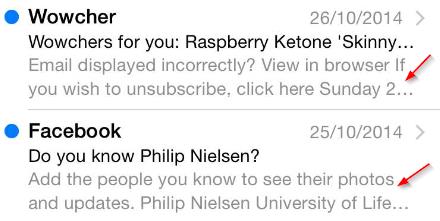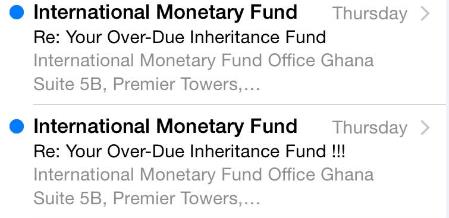Did you know, over 190 billion emails are sent every single day? Almost 100 billion of these emails are B2B and as it stands there are over 900 million business email accounts in the world! Yes, I was shocked when I first heard this as well, but for email marketers this really puts things into perspective; your email is not the only one your contacts will be receiving today and with so many arriving in their inbox each day, you run the risk of never having your email opened.
Here is a screenshot of what my mail apps have accumulated over the years:
I’m guessing not everyone is as bad as me when it comes to cleaning up their inbox but do we really have the time to read every single email we receive?
So with all this traffic, how do you stand out from the crowd and get your share of a good open rate?
Split Testing – Choosing the Right Subject Line
Email marketing is all about first impressions. You want a subject line that appeals to your readership, entices them to open your email and the best way to get it right is to test, not guess.
Split testing, also known as A/B testing, allows you to test a variation in your email. For example, you split your list into three segments. You come up with two different subject lines and send them to the first two segments (keep them small, maybe 10%). You then launch the winning version to the rest of your list.
Below are results from a recent split test I performed:
Version A and B went out to approximately 20% of my total list. Version A won with the highest open rate and was launched to the remaining recipients. As you can see, the final version enjoyed a similar open rate to version A.
Now if the subject line for version B was used for all three versions, the unique opens for version A and the final version would be 264 and 932 respectively.
By performing this split test, I have engaged approximately 265 more people then I would have if I had launched version B to my entire list. I will let you decide how important 265 extra opens can be.
So there you have it, split testing is a brilliant way to test variations in your email and improve open rates. Campaignmaster’s email marketing platform offers you one of the most powerful and intuitive split testing features on the market today.
When it comes to selecting your subject lines, go with something that creates a sense of urgency, make your recipients feel like they will miss out on something great if they do not open your email.
Appeal to your readership’s curiosity. A question or a vague but interesting statement will entice the reader to want to know more.
Try personalising your subject lines. Why not perform a test with a generic subject line and a personalised subject line and see how they fare against each other?
Pre-Header Text
Once you have decided on your subject line, the next logical thing to consider is your pre-header text. The pre-header text appears in the inbox straight after the subject line.
Most email clients use the first bit of text in your template as pre-header text, and you can use this to your advantage. Insert a short summary of your email at the very top. From the example above, Wowcher have failed to do this. Their pr-header text gives no reason for me to open their email.
Here is an example of the right use of pre-header text:
I instantly know that the email is offering me a complimentary copy of a guide and that gives me an additional reason to open their email.
Avoid Spam Triggers
You might hit the nail on the head with your subject line and pre-header text, but none of it matters if your email gets marked as SPAM. There is no sure shot way of predicting if your email will end up in a SPAM folder but avoiding words such as ‘Free’ or an excessive use of ‘£’ symbols is a good start. There are a whole host of spam trigger words you want to avoid and you can find directories for them on the web.
The more you use these spam words, the worse your reputation gets and the more likely you are to end up in the junk folder. This is why I recommend monitoring your sender reputation. If you are a Campaignmaster user, you’re in good hands as our tech teams uses feedback loops to monitor your sender reputation. If there are any flags against your sending domain, you will be informed by us.
It is also worth running your emails through a spam analysis before launching them!
Authentication
Here is a snapshot of two emails I received from the International Monetary Fund that landed straight in my junk folder.
There is no inheritance fund and even if there was, I don’t think the IMF is the right organisation to be dealing with it. So clearly, whoever sent this email is pretending to be from the IMF.
Email clients today use various authentication methods to verify that the email is coming from who it says its coming from. As Gmail was unable to verify the authenticity of the from address for my IMF email, it sent it to my junk folder.
These authentications are in effect digital signatures; they are added to the sending address and are the first thing email clients look to verify before determining the destination of an email.
There are three methods of authentication currently being used at large.
DMARC
Domain-based Message Authentication, Reporting & Conformance. By applying DMARC to a domain, the sender is letting the receiver know the email is protected by SPF and DKIM.
SPF
This tells the email client that the email is from a domain authorized to be used by its administrators.
DKIM
DomainKeys Identified Mail. This method, in simple terms, is a crypted message attached to the sending domain that validates its identity.
If you are a Campaignmaster user, don’t worry about this, we add authentications to your sending address as a standard part of your account setup.
Regular Data Maintenance
Keeping your data clean is arguably the most important aspect of keeping your open rates up.
Ensure the data you hold has been opted in, we always recommend a double opt in. A double opt in is done by sending a verification email at the time of sign up. This may seem tedious but verifying the email address means you are sending to people who are actually expecting your emails.
Ensuring your data is opted in will also help you avoid spam traps. A spam trap is an email address used by email clients to catch spammers. As the email address does not belong to anyone, there is no chance of the email address subscribing to receive communications. Therefore if you are caught sending to this email address, you will be flagged as a spammer and will find your reputation tarnished.
I would also suggest running regular maintenance of your database and sending out re-engagement emails is a good way of doing this.
So there you have it, a few simple techniques to boost your open rates. Don’t forget, as a Campaignmaster user you can enjoy the benefits of a dedicated account manager and support team that can advise you on improving your open rates and much more!













